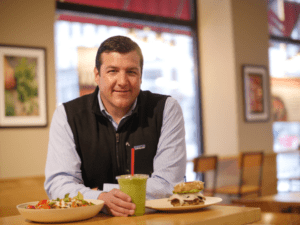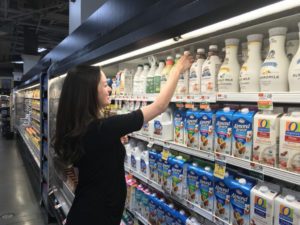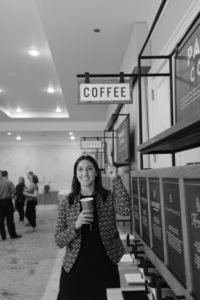
Margaret Skrmetti, Community Engagement Manager, Morton Salt
“Perfect is the enemy of good.” This sentiment has guided my work philosophy for years, ever since receiving a card from a former co-worker, Margaret, printed with these very words. Since we worked together a decade ago, we’ve both shifted careers but more importantly, we’ve become dear friends. One of the most thoughtful, well-spoken and successful people I know, she lives her values through a career in corporate social responsibility and philanthropy that’s spanned organizations from Bank of America and Staples to The Museum of Fine Arts (Boston) and The Field Museum (Chicago).
Following last week’s Business Roundtable announcement re: corporations’ responsibilities extending well beyond profit [more here], I can’t think of a more timely or fitting interview. Is the state of corporate social responsibility (CSR) perfect? No, but we’re getting there.
This interview was conducted Boston to Chicago via phone & was condensed and edited for clarity.
Catching Up
Know you’re taking this call at the end of a well-deserved vacation. Thank you.
Of course, though with a 6 month old, I’m not sure it was much of a vacation. I’m exhausted!
CSR. It’s your passion & life’s work. How is that manifesting today?
I’ve been with Morton Salt for nearly 3 years, where I lead our social responsibility strategy, which entails corporate giving and volunteerism for 2,500+ employees across the US, Canada, and the Bahamas.
On a corporate level, that means helping craft campaigns that build cultural relevance and brand equity – like our Erase Food Waste campaign – and creating tools to measure employee engagement around our giving & volunteer efforts. On a community level, I provide counsel to 20+ facilities across my regions.
How did you end up in a “feel good” career?
[Laughs]. I didn’t set out to do this when leaving school, or see my career as a way to “give back.” But the fact that my work allows me to feel good about what I’m putting out in the world is an unexpected win.
Take us through your career history.
I went to Boston University and studied communications so as one does, I started out in the public relations agency world. At RFBinder, where we met, I was staffed on CSR accounts supporting Staples and Bank of America.
At the time, this was about 10 years ago, most large corporations relied on agencies for their CSR work as part of a broader communications strategy. Few places had someone doing the work full time – that’s really when I figured out I could do this for a living, but that there was a lot missing in between. I set out to be that “in between” in an in-house role, and really act as a translator for both sides.
That’s a great way of putting it – translating the needs of the nonprofit and the expectations of the corporation so that everyone benefits.
Exactly. I found a sweet spot that really interests me. After RFBinder, I moved to into Corporate Relations with The Museum of Fine Arts. I’m passionate about the arts so the role was a natural fit – I got a taste of fundraising, corporate sponsorship, program development and event management.
Then, my husband’s job brought us to Chicago where we are today. After a continued stint in Corporate Relations for Loyola University, I made my way back to the arts at Chicago’s Field Museum as their Corporate Major Gifts Officer. That brings us today and my time at Morton. When I started 3 years ago, the role was new to the company – CSR was happening, but it was spread across the organization. I was able to help centralize everything and build the function from the ground up.
Educate Us
One doesn’t naturally think of salt & CSR.
We have very high brand awareness, and when you ask people about our company they almost always think of the round blue can in their pantry, but there’s so much more. Think pharmaceutical applications, partnerships with municipalities for road salt and a B2B / industrial side of the business. Regardless of application, our salt mines and production facilities are deeply embedded in the communities where our employees live and work so how we give back sets the tone for the next generations and our continued evolution.
As we speak about community, I’ve always wondered to what extent your global upbringing laid the foundation for the type of work you do today.
My dad spent 20 years in the Army, which means we spent time across the US, the Middle East and Northern Africa. We experienced a lot overseas and at the end of the day, it taught me to accept value from all people and ideas. We’re all so much more alike than it seems yet today, we spend so much time and energy talking about differences vs. commonalities. I’m lucky to have found a way to connect people through those commonalities in my work.
For folks looking to enter the CSR space today, what advice can you offer?
In-house CSR jobs are few and far between. While the function has become more established in the past decade, that doesn’t necessarily translate into head count. For example, I’m a team of one.
But, while it can be hard to find opportunities, there are a lot of different ways in. I transitioned into my role from the nonprofit side, but there are company veterans who leverage their in-house expertise to transition into a CSR role which is great, because a big part of the job is culture-building. Knowing where the work can be embedded in the company ethos is key.
Educationally, you’re also seeing more and more dedicated programs. Coming from BU, I don’t like to talk about your alma mater [laughs], but BC has a great CSR center, as does Loyola in Chicago. Most business and public policy programs offer relevant courses and Indiana University even has a School of Philanthropy. There’s always a path in, it just takes time.
I can’t help but think a lot of what it takes to be a successful CSR professional comes from pure business experience. So while college students can study it, is it in their best interest to start out in the sector or transition to it?
We haven’t really had a generation go through the full cycle yet so the jury is still out. But you touched on something important for this profession – we spent the past decade establishing that we deserve a seat at the table and at most organizations, we’ve made it. There’s enough research out there; we no longer have to prove the correlation between the work and employee engagement, consumer affinity or revenue. Now, we’re expected to keep up and demonstrate return just like any other business function so measurement is key. It’s no longer a nice-to-have, showing ROI is a must.
Where does CSR usually live within the organization? If it’s under the CMO, it must be a mandate to balance sales overnight with equity over time and CSR usually falls into the latter bucket.
Because the function is relatively new, no organization structures it the same way. I report to our CMO and that makes sense because a lot of what I do is external partnerships.
However, peers at other companies may sit in HR or Legal – especially if there’s a private foundation involved. Some even sit in Operations if it’s viewed as more of a back-of-house function. To me, where CSR lives defines how the work is focused and how it shows up in the organization.
The landscape has changed so much and now the lines are even more blurred given the advent of mission-driven companies (i.e. Warby Parker). How do you view the emergence of mission-driven business models?
I love when the work is intrinsically part of a company like it is for Warby and Tom’s. Giving back is just their model of doing business so they’re able to focus on the larger story of how they live those values day-to-day. It’s less about what’s on paper and more about demonstrating it, storytelling around it and letting employees champion the effort. So for someone like Tom’s where the mission & business performance are linked, how does it show up in the factories, the call centers, the sales teams? That’s what I like to observe.
Who’s a company you admire in the space today?
There are so many brands people love that have B Corp status and never talk about it, which I find interesting. For example, I recently learned that Athleta is a B Corp.
I’m also fascinated by Salesforce and their 1-1-1- model. From the company’s founding they’ve given 1% of their product, 1% of their equity and 1% of their employees’ time to philanthropic causes and the nonprofit sector. They consistently make top employer lists and it’s clear that their focus on giving back resonates.
Work / Life Harmony
Switching gears – you’re a new mom. How has your view on work changed since you had a child?
I always expected I’d want to go back to work and that didn’t change for me. My idea of who I am and what I want to contribute to the world didn’t change when I had a daughter. Now that we have her, I believe in the mission behind my work even more.
What about new skills?
Let’s see – my ability to multi-task has gone through the roof. I can do anything with one hand now and her in the other!
On a practical front, I’ve tried to optimize mornings by starting my day earlier. That hour before she wakes up is critical me time. We’re out the door by 7am and I mapped a new commute from her daycare to my office, which saves me a lot of time and forces me to stay on schedule. While I’m en route, I get my news from a daily NYT podcast instead of watching the morning news, which I used to love. I’m a Good Morning America fangirl.
I’ve also learned to appreciate the adage “time is money,” especially if I want to enjoy the weekend and still get errands done. My husband and I were late to the game with online grocery shopping but Clicklist has been a game-changer.
Good tips. What advice do you want to make note of for your daughter when she, presumably, enters the workforce?
I’d boil it down to 3 things. First, there will be experiences that are good fits and bad fits, and you learn something from both. Sometimes, you can only connect those dots looking backwards so find what you love and be open to creating something from it. What I do didn’t really exist ten years ago but a path will emerge and you find a way to make it happen.
Second, if you want to find the good fit, find good people. Good coworkers, good bosses, good friends. I spent so much time early in my career trying to map the perfect trajectory, but find the right partners and the rest has a way of sorting itself out.
And finally, work smarter, not harder. That way you can make time to do all the things you have to do and the things you love to do.
So true on working smarter, you get creative. I recently listened to a podcast with Gretchen Rubin, author of The Happiness Project, where she shared a life hack for staying in touch. She sets aside 1 night per month for social gatherings and invites people from all different circles so instead of numerous one-offs, she has a standing time that people can float in and out of. The result is staying connected without it becoming a chore.
That’s such a good idea. There’s so many people I want to see and keep up with and I’ve been especially bad about that since having a baby – I’m going to try that.
Wrapping up, anything else for Cecilia?
Just that, in addition to finding good people, be someone people trust because that opens up a whole range of possibilities.






1 Comment
As someone who is about to start a new role in philanthropy, this was my favorite interview yet! The tips for Cecilia are just as valuable for someone who has been in the workforce for a decade.
Comments are closed for this article!